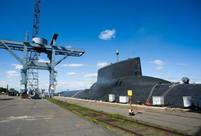

Another major indication of bomber development can be found in Aerospace Knowledge magazine, a defense technology publication in China that boasts a group of well-informed writers who have some inside knowledge of the country's aviation industry and air force.
A series of articles in the magazine's June issue analyzed Chinese bombers' performance and called for the development of a long-range stealth bomber, probably representing a collective notion among industry insiders that China should start designing a long-range strategic bomber as soon as possible.
"A medium-range bomber can't essentially fix the PLA air force's shortcomings in terms of strategic strike and strategic deterrence. ... Thus the air force does need an intercontinental strategic bomber capable of penetrating an enemy's air defenses," one article said.
Unanimous appeal
The petition for a mighty bomber is not new. Chinese military experts have urged the government for at least two years to seek a replacement for the Cold War-era H-6 aircraft.
Wu Guohui, a military equipment researcher at PLA National Defense University, said in October 2013 that large bombers were once ignored by air powers because they were deemed as having poor survivability. However, the United States, Russia and China have acknowledged the advantages of stealth bombers. They can carry out nuclear strikes as well as long-distance precision bombing by conventional weapons, and can be used repeatedly, meaning they are more cost-efficient and agile than a non-reusable ground-to-ground missile.
"The US has decided to invest $1.2 billion every year to develop its second-generation long-range stealth bomber based on its Northrop Grumman B-2 Spirit, while Russia is upgrading its current bombers and developing a new stealth bomber," he said. "China still lags behind in this field, so we should develop our own long-range bomber."
Despite some foreign military analysts' assessment of China as one of the three air powers after the US and Russia that still maintain strategic bombers, the PLA air force must be fully aware that its bomber fleet is much weaker compared with its counterparts in the US and Russia, because it only has an unknown number of H-6 bombers, which are based on the Soviet-era Tu-16 Badger, designed in the 1950s and retired by Russia in the early 1990s, military observers said.
The US Strategic Command now has the Boeing B-52, the Rockwell B-1 and the super-powerful Northrop Grumman B-2, while Russia's Long Range Aviation Command owns the Tupolev Tu-160, Tu-95 and T-22M.
According to Western aviation sources, Aviation Industry Corp of China has continued to upgrade the H-6 with the latest avionics equipment and new materials, and has developed a family of variants that can conduct various tasks, including aerial refueling and reconnaissance. However, the aircraft's antiquated structure, together with old engines, leaves it incapable of performing long-range operations or flying deep into enemy territory to deploy ordnance.
 |  |
 Evolution of Chinese beauties in a century
Evolution of Chinese beauties in a century Creative graduation caps of ‘vigorous elves’
Creative graduation caps of ‘vigorous elves’ Typhoon class strategic Submarine in photos
Typhoon class strategic Submarine in photos Hong Kong college students feel the charm of Hanfu
Hong Kong college students feel the charm of Hanfu Japan’s crimes committed against "comfort women"
Japan’s crimes committed against "comfort women" Odd news:“carrying a rod and asking to be spanked”
Odd news:“carrying a rod and asking to be spanked” Legendary life of a bee-keeping master in Hainan
Legendary life of a bee-keeping master in Hainan 4-year-old cute 'monk' spends summer holiday in temple
4-year-old cute 'monk' spends summer holiday in temple Hong Kong in lens
Hong Kong in lens Editorial: An uncertain road ahead for Greece and EU
Editorial: An uncertain road ahead for Greece and EU China’s class of 2015 gets creative with graduation photos
China’s class of 2015 gets creative with graduation photos Girl power on the pitch
Girl power on the pitch Giant panda Yuanzai turns two at Taipei Zoo
Giant panda Yuanzai turns two at Taipei ZooDay|Week